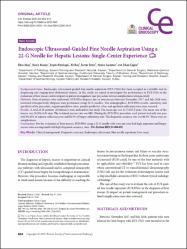Endoscopic ultrasound-guided fine needle aspiration using a 22-g needle for hepatic lesions: Single-center experience

View/
Access
info:eu-repo/semantics/openAccessDate
2021Author
Akay, EbruAtasoy, Deniz
Altınkaya, Engin
Koç, Ali
Ertan, Tamer
Karaman, Hatice
Çağlar, Erkan
Metadata
Show full item recordAbstract
Background/Aims: Endoscopic ultrasound-guided fine needle aspiration (EUS-FNA) has been accepted as a reliable tool in diagnosing and staging intra-abdominal tumors. In this study, we aimed to investigate the performance of EUS-FNA in the evaluation of liver masses and its impact on patient management and procedure-related complications retrospectively.
Methods: Data of patients who underwent EUS-FNA biopsies due to liver masses between November 2017 and July 2018 were retrieved retrospectively. Biopsies were performed using 22-G needles. The demographics, EUS-FNA results, sensitivity and specificity of the procedure, negative predictive value, positive predictive value, and specimen sufficiency rates were assessed.
Results: A total of 25 patients (10 females) were included in the study. The mean age was 62.73 +/- 15.2 years. The mean size of the masses was 34.50 +/- 16.04 mm. The technical success rate was 88%. During the EUS-FNA procedure, each patient had only one pass with 94.45% of aspirate sufficiency rate and 86.3% of biopsy sufficiency rate. The diagnostic accuracy rate was 86.3%. There were no complications.
Conclusions: For the evaluation of liver masses, EUS-FNA using a 22-G needle with even one pass had high aspiration and biopsy success rates accompanied with high diagnostic accuracy rates.

















